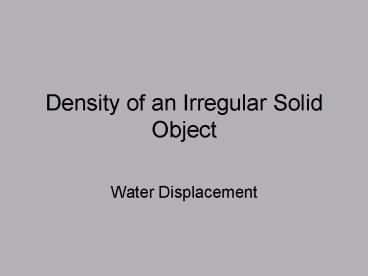Density of an Irregular Solid Object PowerPoint PPT Presentation
1 / 12
Title: Density of an Irregular Solid Object
1
Density of an Irregular Solid Object
- Water Displacement
2
Lets Review
- We already know how to calculate the density of
any system. - We simply use the density equation or refer to
the density pyramid.
3
To Practice
A solid object has a mass of 180 grams and a
volume of 45 cubic centimeters. What is the
density of this object?
Mass 180 grams
Volume 45 cubic centimeters
4
Using the Pyramid
180 grams
45 cm3
4.0 grams/cm3
5
But what if the object does not have a nice
geometric shape?
?
height
width
length
How do you find the volume of a solid object that
does not have convenient length, width, and
height ??
Easy to calculate the volume here !!
6
The answer is Water Displacement !!!
- Fact of Life A solid object will displace
(means pushes out of the way) a volume of water
exactly equal to the volume of the object itself.
(This will be true for any liquid not just
water) - Mass of the object has nothing to do with this.
- Shape of the object has nothing to do with this.
- Only the volume of the object determines how
much water is displaced.
This is why the water rises when you get into the
bath tub
7
How does this work?
We fill a graduated cylinder half full of
water. This original volume of the water is
called the initial volume Vi
Remember that we read the bottom of the
meniscus in a graduated cylinder to know the
volume of the liquid.
8
Next
We add the solid object to the graduated
cylinder. As expected, the water level rises. The
volume of the water after the object has been
added is called the final volume Vf
Remember this first volume was the initial
volume.
9
Now to calculate
The difference between the initial volume and the
final volume is called delta V. You can easily
determine its value by subtraction.
Vf
? V
We write delta V like this
Vi
10
So
If an irregular solid object is placed into a
graduated cylinder that contains 50.0 ml of water
and the water level rises to a final reading of
75.0 ml, we can calculate the ? V is 75.0 50.0
25.0 ml.
Vf 75.0 ml
?V 75.0mL 50.0mL 25.0 ml
Vi 50.0 ml
11
Heres the cool part
It is a fact of life in nature that a liquid
volume of 1.0 ml is exactly equal to (and
therefore interchangeable with) a solid volume of
1.0 cubic centimeter.
So if the object causes a change in the water
volume equal to 25.0 ml, the volume of the object
must be exactly 25.0 cm3.
Remember, we describe the volumes of solids in
cubic centimeters
12
Now to connect to density problems
Remember that density is still equal to mass
divided by volume. That equation does not care
how you get the volume of the object it will
work for both regular and irregular solid
objects.
? V is the volume of the object !!

